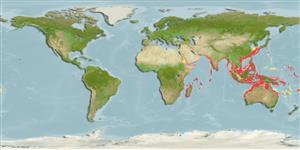Teleostei (teleosts) >
Eupercaria/misc (Various families in series Eupercaria) >
Sciaenidae (Drums or croakers)
Etymology: Atrobucca: Latin, atro = black + Latin, bucca = mouth (Ref. 45335).
More on authors: Jordan & Thompson.
Environment: milieu / climate zone / depth range / distribution range
Ecology
Marine; demersal; depth range 45 - 200 m (Ref. 9772), usually ? - 120 m (Ref. 7483). Deep-water; 38°N - 31°S, 30°E - 137°E
Indo-West Pacific: Mozambique and Natal, South Africa (Ref. 12484), India (Ref. 4373); China, Japan, Philippines, Indonesia, and off northern Australia.
Length at first maturity / Size / Weight / Age
Maturity: Lm 14.5 range ? - ? cm
Max length : 45.0 cm SL male/unsexed; (Ref. 9772); common length : 25.0 cm SL male/unsexed; (Ref. 9772)
Dorsal spines (total): 10 - 11; Dorsal soft rays (total): 27 - 33; Anal spines: 2; Anal soft rays: 7. A small, moderately-deep-bodied species. Swim bladder carrot-shaped, with 24 to 30 pairs of branched appendages, each with a dorsal and a ventral limb, regularly arranged so that the twiglets of the dorsal limb point backwards, and those near the tip of the ventral limb point forwards. The lateral line scales reaching the tip of the caudal fin. The linings of the mouth, gill chamber and body cavity black.
Found in coastal waters down to a depth of 200 m or deeper (Ref. 9772), on seaweed beds and gravel (Ref. 11230). Important food fish.
Life cycle and mating behavior
Maturity | Reproduction | Spawning | Eggs | Fecundity | Larvae
Sasaki, K. and P.J. Kailola, 1988. Three new Indo-Australian species of the sciaenid genus Atrobucca, with a reevaluation of generic limit. Jap. J. Ichthyol. 35(3):261-277. (Ref. 7483)
IUCN Red List Status (Ref. 130435: Version 2024-1)
Threat to humans
Harmless
Human uses
Fisheries: commercial
Tools
Special reports
Download XML
Internet sources
Estimates based on models
Preferred temperature (Ref.
123201): 18.2 - 27.9, mean 24.5 °C (based on 609 cells).
Phylogenetic diversity index (Ref.
82804): PD
50 = 0.5010 [Uniqueness, from 0.5 = low to 2.0 = high].
Bayesian length-weight: a=0.00832 (0.00527 - 0.01312), b=3.03 (2.90 - 3.16), in cm total length, based on LWR estimates for this species & (Sub)family-body (Ref.
93245).
Trophic level (Ref.
69278): 4.0 ±0.69 se; based on food items.
Generation time: 4.8 (3.1 - 7.6) years. Estimated as median ln(3)/K based on 11
growth studies.
Resilience (Ref.
120179): Medium, minimum population doubling time 1.4 - 4.4 years (K=0.15-0.3).
Fishing Vulnerability (Ref.
59153): High vulnerability (56 of 100).
Climate Vulnerability (Ref.
125649): High to very high vulnerability (69 of 100).
Nutrients (Ref.
124155): Calcium = 25.4 [14.4, 58.5] mg/100g; Iron = 0.379 [0.177, 0.825] mg/100g; Protein = 18.5 [17.3, 19.7] %; Omega3 = 0.343 [0.154, 0.625] g/100g; Selenium = 13 [6, 30] μg/100g; VitaminA = 14.3 [2.9, 74.6] μg/100g; Zinc = 0.413 [0.281, 0.626] mg/100g (wet weight);
